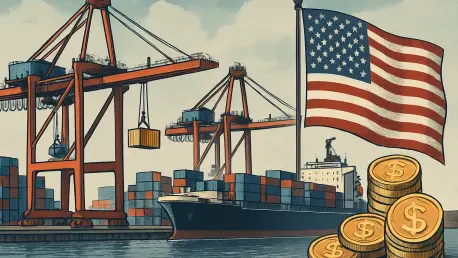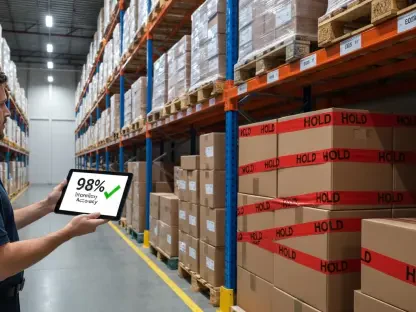In a landscape where global trade is the lifeblood of economic stability, the United States has thrown a significant curveball by imposing a 100% tariff on ship-to-shore cranes and related cargo handling equipment tied to China, effective November 9. This bold move by the Office of the U.S. Trade Representative (USTR) underscores a critical pivot in market dynamics, aiming to reshape supply chains in the maritime logistics sector. With China dominating the production of port equipment, this policy not only challenges existing trade patterns but also raises questions about cost implications and sourcing alternatives for U.S. port operators.
The importance of this analysis lies in understanding how such tariffs ripple through the market, affecting everything from equipment costs to operational timelines at major U.S. ports. As trade tensions with China escalate, this measure reflects a strategic push toward economic security over unfettered globalization. The following sections delve into current market trends, data-driven insights, and projections to provide a comprehensive view of what this means for stakeholders in the logistics and shipping industries.
This examination serves as a guide for businesses navigating these turbulent waters, offering clarity on immediate impacts and long-term strategies. By dissecting the motivations behind the tariffs and their potential to redefine supply chains, the analysis aims to equip industry players with actionable insights to adapt to a rapidly evolving trade environment.
Market Trends and Data-Driven Insights
Current Landscape: Dominance of Chinese Port Equipment
The U.S. port equipment market has long been characterized by a heavy reliance on Chinese-manufactured ship-to-shore cranes, with industry estimates suggesting that over 80% of such machinery at major ports originates from Chinese suppliers. This dominance stems from competitive pricing often backed by state subsidies, allowing Chinese firms to undercut global competitors. The imposition of a 100% tariff directly targets this dependency, aiming to disrupt a market structure that has favored cost over strategic autonomy for decades.
Data from maritime logistics reports highlights the scale of this reliance, with key ports like Los Angeles and Long Beach handling billions in trade annually using predominantly Chinese equipment. The sudden tariff hike introduces a cost barrier that could double acquisition expenses for port operators overnight. While the policy includes exemptions for cranes contracted before April 17 of this year and arriving by April 18, 2027, the broader trend indicates a sharp pivot away from Chinese supply chains, pushing operators to reassess sourcing strategies amid tight budgets.
This shift is not without friction, as the market currently lacks sufficient domestic or alternative international suppliers to fill the gap left by Chinese products. The immediate trend points to potential delays in port modernization projects, as operators grapple with higher costs and longer lead times for equipment procurement. This bottleneck could slow the throughput of goods, impacting broader supply chain efficiency at a time when global trade volumes are on the rise.
Emerging Patterns: Policy Impacts and Industry Response
Beyond the initial shock of the tariffs, emerging market patterns reveal a complex interplay of policy and industry adaptation. The USTR has paired the crane tariffs with additional measures, such as a weight-based fee of $46 per net ton for foreign-vessel operators transporting automobiles, effective since October 14. Furthermore, potential tariffs of up to 150% on other port machinery, like rubber tire gantry cranes, are under public comment until November 10, signaling a comprehensive approach to curbing Chinese influence in maritime infrastructure.
Industry responses vary, with some port operators exploring partnerships with manufacturers in allied nations such as Japan or Germany, though these alternatives often come with higher price tags and require significant lead time to establish supply agreements. Market analysis suggests that while these shifts could bolster long-term resilience, short-term disruptions are inevitable, potentially increasing operational costs by 15-20% in the near term. Smaller ports, lacking the financial cushion of larger hubs, may face the brunt of these challenges, risking competitive disadvantages.
Another notable pattern is the push for domestic manufacturing, spurred by the tariff’s intent to incentivize U.S.-based production. However, the current capacity of American firms to produce heavy port equipment at scale remains limited, with industry data indicating a lag of several years before meaningful output can be achieved. This gap underscores a critical market tension between policy ambitions and practical realities, shaping a cautious outlook among logistics stakeholders.
Future Projections: Supply Chain Realignment and Economic Fallout
Looking ahead, projections suggest that the tariffs will catalyze a broader realignment of global supply chains within the maritime sector over the next two to three years. Countries like Vietnam and South Korea are poised to emerge as alternative suppliers, though their capacity to meet U.S. demand hinges on infrastructure investments and trade pacts that are still in early stages. Market forecasts predict a gradual diversification of sourcing, with non-Chinese suppliers potentially capturing 30% of the U.S. port equipment market by 2028 if current trends hold.
Economically, the fallout could be significant, with higher equipment costs likely to translate into elevated shipping rates, ultimately passed on to consumers. Analytical models estimate a potential 5-7% increase in logistics costs for U.S. importers over the next year, straining sectors reliant on just-in-time inventory systems. Retaliatory measures from China, such as tightened controls on rare earth minerals, could further complicate the picture, impacting industries beyond maritime logistics and adding layers of uncertainty to market projections.
Technological innovation offers a potential buffer, with advancements in automated port systems and AI-driven logistics gaining traction as solutions to reduce reliance on traditional equipment. While still in early adoption phases, these technologies could reshape market dynamics by decreasing the need for large-scale crane deployments. Projections indicate that ports investing in automation now could mitigate tariff-related cost spikes by up to 10% over the next five years, though upfront capital requirements remain a hurdle for widespread implementation.
Reflecting on Market Shifts and Strategic Pathways
Reflecting on the analysis, the imposition of 100% tariffs on China-linked port cranes marks a pivotal moment in U.S. trade policy, fundamentally altering the market landscape for maritime logistics. The data underscores a deep dependency on Chinese equipment, while emerging patterns reveal both the challenges of immediate cost increases and the slow but necessary shift toward alternative sourcing. Projections paint a future of realigned supply chains, tempered by economic fallout and the promise of technological innovation.
For industry stakeholders, the path forward demands proactive adaptation, with a focus on forging partnerships with non-Chinese suppliers to secure equipment pipelines. Exploring federal incentives or tax breaks to offset transition costs emerges as a viable strategy, ensuring competitiveness amid rising expenses. Additionally, investing in automation and digital logistics solutions offers a long-term avenue to reduce vulnerability to trade disruptions.
Beyond immediate tactics, the broader consideration is how to balance economic security with global trade realities, advocating for policies that support domestic manufacturing without crippling port efficiency. This juncture in market history challenges businesses to rethink dependency, pushing for resilience through diversified supply networks and innovation. The lessons from this tariff episode pave the way for a more strategic approach to navigating U.S.-China trade tensions in the years that follow.









